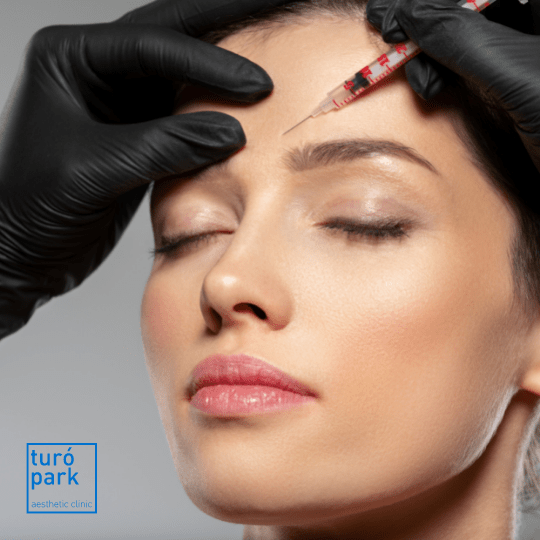The differences between hyaluronic acid and neuromodulator injections and treatments, what to use them for and where to go in Barcelona to achieve your desired final results.
It is believed that both have the same effect or that they serve the same purpose, but this is not the case. Although both substances are intended to rejuvenate the face, they are not the same, as each has a specific composition and function.
For this reason it is very important to put yourself in the hands of specialists. At Turó Park Aesthetic Clinic, our specialists in aesthetic medicine will inform you of the differences and will advise you on the most suitable treatment for you based on your needs and always in a personalised way, achieving totally natural results.
What is hyaluronic acid?
It is a glucose molecule of natural origin, which is found naturally and permanently in our body, specifically in a higher percentage in the skin.
It is responsible for keeping the skin hydrated and its main function is to absorb and retain water molecules, filling the dermis and increasing volume from within.
As the years go by, its concentration decreases, which is why wrinkles appear. To combat this effect, it is advisable to apply creams containing hyaluronic acid and it can also be injected by a specialist to fill wrinkles.
What are neuromodulators?
They are produced naturally by the bacterium Clostridium botulinum and has the property of inhibiting nerve transmission in muscles, thus preventing their contraction.
When injected into the face, neuromodulators act on the nerves that control the muscles, preventing them from contracting, thus giving a much smoother and relaxed appearance to the face.
Fundamental differences between hyaluronic acid and neuromodulators
Hyaluronic acid
- When injected, it fills wrinkles, furrows, facial folds and can also be used to improve the appearance and hydration of the lips.
- It is injected by micro-injections directly into the skin, replenishing the natural hyaluronic acid that has been lost over the years.
- Hyaluronic acid is usually used in the lower third of the face.
- It is a natural substance produced by our body and is completely biocompatible.
- The duration of the hyaluronic acid will depend on the absorption of the substance by the patient, its results can last up to 18 months.
- In dentistry it is used to improve healing, causing the gums and oral mucosa to regenerate. It can also be used in surgical treatment of temporomandibular joint dysfunction.
- It is also useful in the treatment of degenerative diseases of the joints, by performing infiltrations it can reduce pain and regenerate cartilage.
Neuromodulators
- It is applied to the facial muscles that we want to relax.
- When injected, it paralyses the muscles and prevents the wrinkles caused by these movements.
- It is usually used in the upper third of the face.
- They are an external protein, i.e. it is not produced by our body by nature.
- It lasts for 4 to 6 months.
- In dentistry, it is used to re-establish the balance between the lowering and raising muscles of the jaw, reducing the force of contraction of the muscles of the jaw apparatus.
But as we have already mentioned, both have the same objective, to rejuvenate the skin, so they can be applied together to achieve better results. Both substances have a specific duration and are progressively reabsorbed, after which a new session can be proposed.
The different treatments that can be performed with hyaluronic acid and neuromodulatora
The source of confusion is that both treatments often treat similar conditions. However, there are variations and, as we have mentioned, the method of the treatments is different, even the final results.
Hyaluronic acid
- Skin rejuvenation by filling out wrinkles
- Lip, cheek, chin and other area augmentation
- Osteoarthritis / joint pain
- Repair of gum tissue
- Tissue hydration
Neuromodulators
- Treat wrinkles
- Acne control
- Temporary lifting
- Nose reshaping
- Lip lift
- Smoothing the neck
- Strengthening the jowls
- Treating migraine
- To treat excessive sweating
- Solution for a gummy smile
As can be seen in the above points, both treatments provide a wide range of solutions to aesthetic and functional problems. It is essential that you get advice from a specialised professional to obtain an optimum result, and to rule out any contraindications to the treatment.

Neuromodulators and hyaluronic acid treatments: our responses to your most frequently asked questions
This question can only be answered by you, according to your desired final results and personal medical history.
The best way to find out is to book a pre-procedure consultation with the aesthetic medicine specialist to find out any possible contradictions and which procedure is best for you personally.
The most frequent contraindications to neuromodulator injections are the following:
Contraindications for hyaluronic acid injections are the following;
It is to be noted that there are fewer for hyaluronic acid injections as they are biocompatible. Neither of the treatments are recommended for pregnant or breastfeeding women.
Both sorts of injections do not usually cause any complications. However, slight swelling, redness and very superficial bruising may occur immediately after the procedures. These are nothing to worry about but if they persist it would be wise to consult your doctor.
Most of these can be avoided completely by consulting a highly-qualified professional.
Our aesthetic medicine specialists

Dr. Lloyd Nanhekhan

Dr. Éléna Bensoussan

Dr. Rob van der Veen

Dr. Alejandro Mazarro

Dr. Claudia Wand
